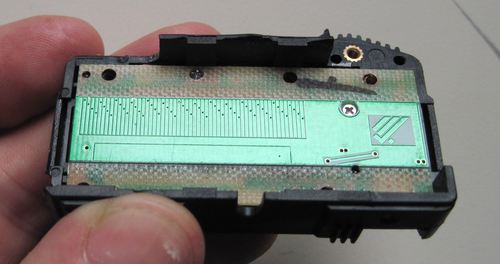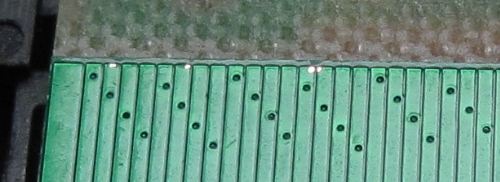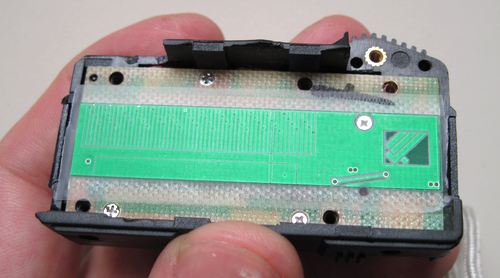Fixing digital calipers
 I'd had this set of digital calipers for about a year when it started to act funny.
It still seemed to work, but the display would sometimes jump to a new random value.
That of course, makes the device pretty useless for its intended purpose.
I figured maybe it was some sort of cracked solder joint, and maybe
this reflow technique
could fix it.
I'd had this set of digital calipers for about a year when it started to act funny.
It still seemed to work, but the display would sometimes jump to a new random value.
That of course, makes the device pretty useless for its intended purpose.
I figured maybe it was some sort of cracked solder joint, and maybe
this reflow technique
could fix it.
 It took me a while to figure out how to get the caliper apart. There was a metalized
sticker on the back with a table of screw sizes, and under it were four screws.
Once I found and removed those, the whole electronics part detached from the
rest of the calipers.
It took me a while to figure out how to get the caliper apart. There was a metalized
sticker on the back with a table of screw sizes, and under it were four screws.
Once I found and removed those, the whole electronics part detached from the
rest of the calipers.
 Once I had the electronics off, I could see how it works. The up and down
traces on the back of the circuit board capacitively couple to some sort of scale behind
the numbers on the caliper. The strips are a lot wider than the calipers .01 mm minimum
resolution, so a lot of interpolation has to happen to get the position down to
that resolution.
Once I had the electronics off, I could see how it works. The up and down
traces on the back of the circuit board capacitively couple to some sort of scale behind
the numbers on the caliper. The strips are a lot wider than the calipers .01 mm minimum
resolution, so a lot of interpolation has to happen to get the position down to
that resolution.
But inspecting it closely, I could see a few spots where the solder mask had flaked off
the circuit board. So my theory was that the flaked off solder mask was allowing
the trace of solder to make contact with the edge of the calipers, which it shouldn't.
Really, it seems almost inevitable that the solder mask might rub off the circuit
board at some point.
 This photo is a magnification of a section of the above photo. It shows the flaked off solder
mask more clearly. This means that the traces could potentially make contact with the
metal frame of the calipers, which would completely swamp out whatever the unit was trying
to read capacitively.
This photo is a magnification of a section of the above photo. It shows the flaked off solder
mask more clearly. This means that the traces could potentially make contact with the
metal frame of the calipers, which would completely swamp out whatever the unit was trying
to read capacitively.
I had also observed that if I just used the caliper with the battery lid open, and held
the calipers in my hand while at the same time holding the battery in place with my
thumb, the calipers acted even more strangely. I'm guessing that the conductive connection my
fingers made between the metal frame and the battery also contributed to messing up any
capacitative reading.

 My fix to the caliper was to just put some thin Scotch tape over the back of the circuit board,
and put it back together. It worked. So it was that, and not cracked solder joints
as I had initially suspected.
My fix to the caliper was to just put some thin Scotch tape over the back of the circuit board,
and put it back together. It worked. So it was that, and not cracked solder joints
as I had initially suspected.
I retested the caliper against my dial calipers
and found that it would disagree with the other sometimes by as much
as .04 mm (or about .0015")
plus or minus. I'm guessing the extra spacing introduced by the Scotch tape somehow
altered the capacitive coupling to mess up the interpolation just a bit.
For woodworking, this sort of inaccuracy is still acceptable.
Unfortunately, the whole thing has shaken my faith in digital calipers a bit. With the
sensor elements as coarse as they are, its hard to trust that interpolation down to 0.01 mm,
even on an undamaged set of calipers. So nowadays, if I want to be really sure of a reading,
I'll use my trusty old dial calipers. Digital calipers sure are handy though when I need
to record lots of results, like with my
wood shrinkage tests
or my screwdriver-drop wood hardness tests.
I may have to buy another one the next time I do experiments like that where accuracy matters
a lot.
So if you have some cheap digital caliper that suddenly starts erratically changing
the displayed numbers, pop it apart and have a look at the back of the circuit board.
A simple piece of Scotch tape might be all it takes to fix it.
 It took me a while to figure out how to get the caliper apart. There was a metalized
sticker on the back with a table of screw sizes, and under it were four screws.
Once I found and removed those, the whole electronics part detached from the
rest of the calipers.
It took me a while to figure out how to get the caliper apart. There was a metalized
sticker on the back with a table of screw sizes, and under it were four screws.
Once I found and removed those, the whole electronics part detached from the
rest of the calipers.
 I'd had this set of digital calipers for about a year when it started to act funny.
It still seemed to work, but the display would sometimes jump to a new random value.
That of course, makes the device pretty useless for its intended purpose.
I figured maybe it was some sort of cracked solder joint, and maybe
this reflow technique
could fix it.
I'd had this set of digital calipers for about a year when it started to act funny.
It still seemed to work, but the display would sometimes jump to a new random value.
That of course, makes the device pretty useless for its intended purpose.
I figured maybe it was some sort of cracked solder joint, and maybe
this reflow technique
could fix it.
 Once I had the electronics off, I could see how it works. The up and down
traces on the back of the circuit board capacitively couple to some sort of scale behind
the numbers on the caliper. The strips are a lot wider than the calipers .01 mm minimum
resolution, so a lot of interpolation has to happen to get the position down to
that resolution.
Once I had the electronics off, I could see how it works. The up and down
traces on the back of the circuit board capacitively couple to some sort of scale behind
the numbers on the caliper. The strips are a lot wider than the calipers .01 mm minimum
resolution, so a lot of interpolation has to happen to get the position down to
that resolution.
 This photo is a magnification of a section of the above photo. It shows the flaked off solder
mask more clearly. This means that the traces could potentially make contact with the
metal frame of the calipers, which would completely swamp out whatever the unit was trying
to read capacitively.
This photo is a magnification of a section of the above photo. It shows the flaked off solder
mask more clearly. This means that the traces could potentially make contact with the
metal frame of the calipers, which would completely swamp out whatever the unit was trying
to read capacitively.

 My fix to the caliper was to just put some thin Scotch tape over the back of the circuit board,
and put it back together. It worked. So it was that, and not cracked solder joints
as I had initially suspected.
My fix to the caliper was to just put some thin Scotch tape over the back of the circuit board,
and put it back together. It worked. So it was that, and not cracked solder joints
as I had initially suspected.